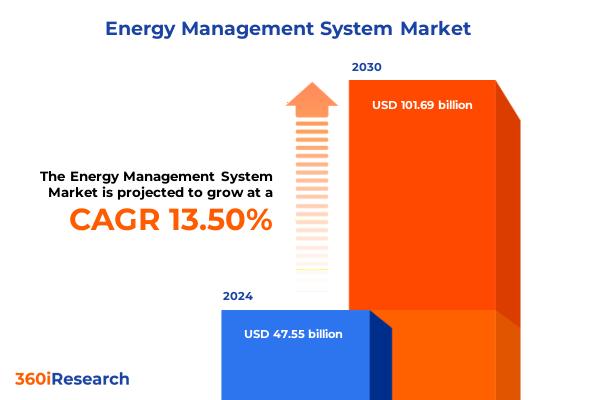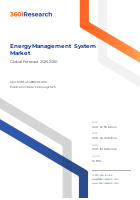The Energy Management System Market size was estimated at USD 47.55 billion in 2024 and expected to reach USD 54.03 billion in 2025, at a CAGR 13.50% to reach USD 101.69 billion by 2030.

Comprehensive Introduction to Energy Management System Trends
The energy management ecosystem stands at the intersection of technological evolution and the rising demand for sustainable practices. In today’s competitive landscape, energy management systems (EMS) are not just about monitoring consumption but are central to strategic decision-making that drives efficiency and cost optimization. These advanced systems integrate hardware, software, and services to provide real-time data analytics, enabling companies to optimize energy utilization and reduce operational overhead.
This comprehensive environment is characterized by an increasing reliance on digitalization and smart technologies. Companies worldwide are embracing innovations that facilitate the integration of renewable energy sources, automated control systems, and advanced energy storage solutions. Evolving market dynamics, driven by stringent regulations and the need for environmental sustainability, have catalyzed significant investments in EMS.
The convergence of these technologies with operational best practices has not only transformed traditional energy management but also reshaped the strategic priorities of a wide spectrum of industries. By leveraging robust data insights and automation capabilities, organizations can achieve enhanced operational resilience in challenging market conditions. This introduction sets the stage for a deep dive into transformative industry shifts, detailed segmentation, regional nuance, key players, actionable recommendations, and a forward-looking call-to-action that collectively enhance the understanding of the current EMS market landscape.
Transformative Shifts Redefining the Energy Management Landscape
The ongoing digital revolution has ushered in a new era for energy management systems, fundamentally altering industry dynamics. Recent transformative shifts focus on integrating advanced analytics, cloud computing, and Internet of Things (IoT) technologies to bring unparalleled precision and responsiveness to energy utilization. This paradigm shift is spurring a transition from reactive maintenance to proactive management, ensuring that systems are continuously optimized and energy waste is minimized.
A significant driver behind these changes is the convergence of automation and smart sensor technologies that provide near-instantaneous feedback and operational adjustments. With the rollout of next-generation sensors and controllers, energy systems are being re-engineered to offer not only enhanced control but also predictive intelligence. This facilitates a more nimble response to consumption patterns, reduces downtime, and identifies potential inefficiencies before they escalate into costly issues.
Moreover, regulatory pressures and a global emphasis on reducing carbon footprints have accelerated innovation within this space. The incorporation of renewable energy sources into EMS architectures is becoming increasingly prevalent, underpinning initiatives for cleaner, greener energy practices. Organizations are now placing a heightened focus on achieving sustainability goals without compromising operational efficiency. These transformative trends continue to redefine competitive benchmarks and drive the evolution of EMS in a direction that champions both environmental responsibility and operational excellence.
Key Segmentation Insights Across the Energy Management System Market
A detailed analysis of the market segmentation yields invaluable insights into the diverse components and applications that collectively shape the EMS industry. The market is extensively studied across three distinct dimensions. Firstly, from the perspective of component analysis, the landscape is dissected into hardware, services, and software. Diving deeper, the hardware category examines controllers, sensors, and smart meters – each playing a critical role in harnessing real-time operational data. Equally, the services segment evolves through consulting, implementation, and maintenance, offering indispensable support to technology integration and ongoing system management. Complementing these, the software facet covers areas such as carbon reporting, residential management, and utility management, which are essential in meeting stringent compliance frameworks and operational demands.
Furthermore, applications in the industrial sector are meticulously analyzed, with specific emphasis on chemical, food and beverage, and manufacturing domains. The commercial sector, on the other hand, is evaluated within the context of hotels and restaurants, offices and buildings, and retail environments. Residential applications are also studied, focusing on both apartments and individual homes. Such segmentation enables stakeholders to identify precise market opportunities and align strategic investments across varied consumer bases while capturing emerging trends and localized demand dynamics. These segmentation insights not only highlight the inherent complexities of the industry but also underscore the need for tailored strategies to achieve competitive advantages in an ever-evolving market landscape.
This comprehensive research report categorizes the Energy Management System market into clearly defined segments, providing a detailed analysis of emerging trends and precise revenue forecasts to support strategic decision-making.
- Component
- Application
- Commercial
- Residential
Emerging Regional Dynamics and Market Insights
Regional analysis provides a nuanced understanding of the global EMS market, where different geographies exhibit unique growth trajectories and challenges. The Americas continue to demonstrate robust market activity, driven by strong industrial infrastructure and progressive governmental policies that encourage energy optimization. This region’s mature industrial practices and broad adoption of smart technologies underscore its leading role in EMS innovation.
In contrast, the Europe, Middle East & Africa region portrays a blend of mature markets alongside rapidly developing economies that are progressively investing in sustainable energy practices. Regulatory mandates driven by environmental concerns have stimulated significant sector-wide investments, fostering a culture of continuous improvement and modern technology integration. Emerging economies within this cluster are gradually transforming legacy energy systems while embracing new technological paradigms.
The Asia-Pacific region represents a dynamic growth frontier with increasing urbanization and industrial expansion. Accelerated economic developments and improvements in infrastructure have catalyzed the adoption of advanced EMS solutions in this region. This geographical segment, with its diverse market conditions, underscores the necessity for customized strategies to address local challenges and capitalize on rapidly evolving opportunities.
This comprehensive research report examines key regions that drive the evolution of the Energy Management System market, offering deep insights into regional trends, growth factors, and industry developments that are influencing market performance.
- Americas
- Asia-Pacific
- Europe, Middle East & Africa
Leading Companies Steering Industry Innovation and Growth
In an environment marked by fast-paced technological advancements and heightened regulatory standards, several companies have emerged as key innovators driving growth and transformation within the EMS market. Global leaders such as ABB Ltd. and Broadcom Inc. have continuously showcased their commitment to integrating cutting-edge technologies with reliable hardware solutions. Cisco Systems, Inc. and Delta Electronics, Inc. exemplify the convergence of digital network protocols and power management systems to deliver intelligent, connected products.
Moreover, industry giants like E.On SE, Eaton Corporation PLC, and Emerson Electric Co. have strategically diversified their offerings to include comprehensive services that bridge the gap between hardware implementation and software analytics. The incorporation of big data and cloud-based solutions by organizations such as General Electric Company and Honeywell International, Inc. has further pushed the envelope in predictive and integrative energy management. Innovative contributions from International Business Machine Corporation, Itron, Inc., Johnson Controls Inc., and Landis+Gyr AG underscore the importance of cohesive strategies that synchronize technology and service-based models.
Legrand S.A., Lutron Electronics Co., Inc., Mitsubishi Electric Corporation, and Robert Bosch GmbH have set high benchmarks in smart building management, while Rockwell Automation, Inc. and SAP SE have harnessed the power of software to drive utility and carbon reporting solutions. Companies like Schneider Electric SE, Siemens AG, Sunverge Energy, Inc., Tantalus Systems Holding Inc., Toshiba Corporation, and Yokogawa Electric Corporation continue to shape the market landscape by offering forward-looking solutions that address both current and future demands. These firms are not only at the forefront of technological innovation but also pioneers in creating integrated systems capable of delivering measurable, sustainable energy savings in an increasingly competitive market.
This comprehensive research report delivers an in-depth overview of the principal market players in the Energy Management System market, evaluating their market share, strategic initiatives, and competitive positioning to illuminate the factors shaping the competitive landscape.
- ABB Ltd.
- Broadcom Inc.
- Cisco Systems, Inc.
- Delta Electronics, Inc.
- E.On SE
- Eaton Corporation PLC
- Emerson Electric Co.
- General Electric Company
- Honeywell International, Inc.
- International Business Machine Corporation
- Itron, Inc.
- Johnson Controls Inc.
- Landis+Gyr AG
- Legrand S.A.
- Lutron Electronics Co., Inc.
- Mitsubishi Electric Corporation
- Robert Bosch GmbH
- Rockwell Automation, Inc.
- SAP SE
- Schneider Electric SE
- Siemens AG
- Sunverge Energy, Inc.
- Tantalus Systems Holding Inc.
- Toshiba Corporation
- Yokogawa Electric Corporation
Actionable Recommendations and Strategic Initiatives for Industry Leaders
For decision-makers and industry leaders aiming to maintain a competitive edge in the fast-evolving EMS market, several actionable recommendations emerge from the current trends and segmentation insights. Investing in emerging digital technologies such as IoT, artificial intelligence, and cloud analytics is paramount. These technologies serve as the backbone for developing systems that offer predictive maintenance and real-time performance insights. Strategic partnerships between technology suppliers and service providers can further enhance the development and deployment of holistic solutions that address the multifaceted needs of modern energy management.
Furthermore, embracing a customer-centric approach by tailoring services to meet diverse end-user requirements fosters long-term sustainability. Leaders are encouraged to optimize supply chain dynamics and invest in cutting-edge research and development initiatives. A proactive stance towards regulatory compliance and environmental standards will not only mitigate risks but also elevate market positioning. Such strategic initiatives are essential for capturing new market segments and driving operational excellence.
Explore AI-driven insights for the Energy Management System market with ResearchAI on our online platform, providing deeper, data-backed market analysis.
Ask ResearchAI anything
World's First Innovative Al for Market Research
Concluding Reflections on Market Dynamics and Strategic Future Outlook
The evolving EMS landscape is a testament to the rapid interplay of technological innovation, stringent regulatory environments, and shifting consumer expectations. Deep-dive analyses across segmentation, regional insights, and corporate innovation highlight the multidimensional challenges and opportunities facing the industry. As organizations continue integrating digital tools and advanced analytics, they are positioned to achieve transformative operational efficiencies and competitive advantages.
The insights presented herein reflect both the current state and the dynamic future of energy management. By aligning strategic priorities with technological advancements and localized market trends, industry stakeholders can confidently move towards a future marked by enhanced sustainability and operational resiliency. This comprehensive exploration serves as a call for introspection and proactive strategy formulation, urging industry leaders to continually evolve in response to the complex market landscape.
This section provides a structured overview of the report, outlining key chapters and topics covered for easy reference in our Energy Management System market comprehensive research report.
- Preface
- Research Methodology
- Executive Summary
- Market Overview
- Market Insights
- Energy Management System Market, by Component
- Energy Management System Market, by Application
- Energy Management System Market, by Commercial
- Energy Management System Market, by Residential
- Americas Energy Management System Market
- Asia-Pacific Energy Management System Market
- Europe, Middle East & Africa Energy Management System Market
- Competitive Landscape
- List of Figures [Total: 25]
- List of Tables [Total: 369 ]
Connect with Ketan Rohom for In-Depth Market Research Insights
Engage directly with Ketan Rohom, Associate Director, Sales & Marketing, to access the detailed market research report crafted for industry visionaries. Take this opportunity to delve further into the sophisticated strategies, technological trends, and comprehensive data sets that are fueling growth within the EMS market. Reach out today to secure your copy and empower your organization with actionable intelligence for a sustainable competitive advantage.

- How big is the Energy Management System Market?
- What is the Energy Management System Market growth?
- When do I get the report?
- In what format does this report get delivered to me?
- How long has 360iResearch been around?
- What if I have a question about your reports?
- Can I share this report with my team?
- Can I use your research in my presentation?




